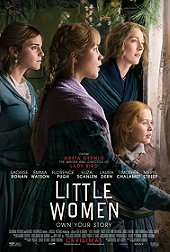There’s more than a little bit of Louisa May Alcott in Jo March, and there’s also a bit of Jo March in Greta Gerwig. Not only does Gerwig prove that there’s still life in Little Women, Alcott’s oft filmed novel of four daughters coming of age in the Civil War, but that there’s still nuances and reflexive layers to mine in the material. Gerwig restores various bits of autobiographical detail to the material providing an already proto-feminist work with a stronger voice.
We begin in the middle of the narrative with Jo (Saoirse Ronan) living in New York and trying to sell her stories to a disinterested editor (Tracy Letts), and move backwards in time to see how her youth framed her present. Scenes of Jo scribbling ambidextrously, one of several points of Alcott’s own life that get woven in, will suddenly move backwards to show her love of writing plays as the seeds of her eventual present. It’s a smart way to differentiate this adaptation from the straight-through versions starring Katharine Hepburn, June Alyson, or Winona Ryder.
This structure provides not just bits of detail and meaning to things like Jo’s sibling rivalry with Amy (Florence Pugh, simply marvelous), but in shaping our vision of Jo’s bucking of societal conventions while simultaneously thinking she should subsume to them. She scoffs at prospects like marriage while chasing after a fulfilling artistic life, and the film’s third-act treatment of Jo being partnered off is treated as a joke. Gerwig, Alcott, and Jo all combine artistic voices to break the fourth wall and underscore that this endgame decision was one fostered upon them by outside forces.
I suppose some of your adoration of this material will rely upon your ability and tolerance for scenes of women chattering away. Frankly, I wish more films would be like this. It’s a joy to simply sit back and watch actresses as varied and talented as Ronan, Pugh, Laura Dern, Meryl Streep, and Eliza Scanlon argue, laugh, support each other and offer bits of advice. These various personalities provide a wide range of color and ideologies from Streep’s elderly Aunt March being a bit of a battle-axe to Dern’s Marmee transforming volcanic emotional responses to muted self-sacrifice and neighborly support.
Of course, being Little Women, the four sisters get the largest amount of screen time. Ronan remains one of the best actresses of her generation with her ability to seemingly project multiple thoughts and unspoken feelings with just her body language and mercurial transition of facial muscles. Emma Watson gets a turn as Meg, the oldest of the sisters and the one most clearly repeating the life choices of her parents by marrying for love instead of money. Eliza Scanlon manages to make Beth a realistic character instead of the near saintly presence other versions have presented her as, and her resignation in the face of illness is heartbreaking.
While Pugh makes Amy March a more sympathetic and complicated figure than the spoiled brat of prior adaptations. Yes, Amy is a bit of a brat, but she’s also clear-eyed enough to realize the transactional and economic realities of a good marriage for someone in her station and era. It is this scene that best encapsulates what Gerwig is trying to reframe and discuss in this version of the story, the societal and financial pressures that linger upon the family. Each version of Little Women reflects something about the wider culture at the time with the 1949 exploring post-war euphoria and the 1994 underlining the value and defining nature of work, for instance. The 2019 version explores the then-versus-now dynamics at play within the material and transforms Jo from just a self-interest of its original author and into something more complex.
 Login
Login